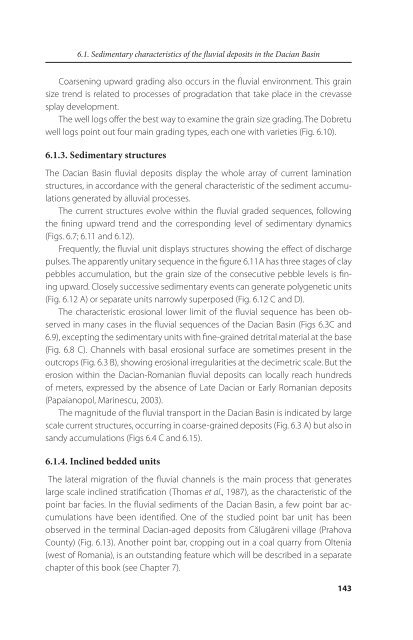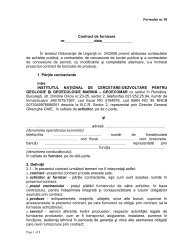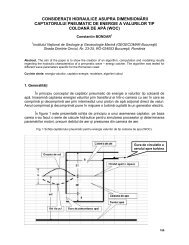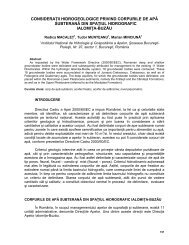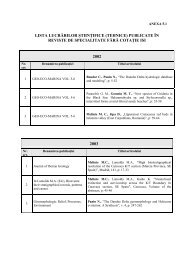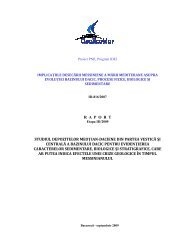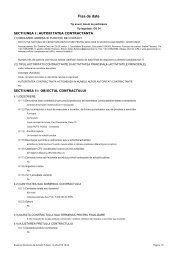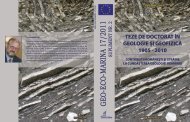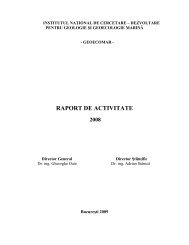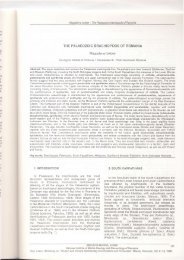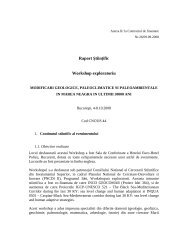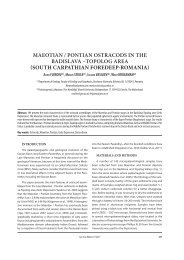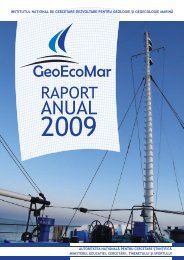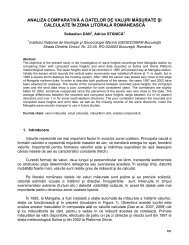DACIAN BASIN - GeoEcoMar
DACIAN BASIN - GeoEcoMar
DACIAN BASIN - GeoEcoMar
Create successful ePaper yourself
Turn your PDF publications into a flip-book with our unique Google optimized e-Paper software.
6.1. Sedimentary characteristics of the fluvial deposits in the Dacian Basin<br />
Coarsening upward grading also occurs in the fluvial environment. This grain<br />
size trend is related to processes of progradation that take place in the crevasse<br />
splay development.<br />
The well logs offer the best way to examine the grain size grading. The Dobretu<br />
well logs point out four main grading types, each one with varieties (Fig. 6.10).<br />
6.1.3. Sedimentary structures<br />
The Dacian Basin fluvial deposits display the whole array of current lamination<br />
structures, in accordance with the general characteristic of the sediment accumulations<br />
generated by alluvial processes.<br />
The current structures evolve within the fluvial graded sequences, following<br />
the fining upward trend and the corresponding level of sedimentary dynamics<br />
(Figs. 6.7; 6.11 and 6.12).<br />
Frequently, the fluvial unit displays structures showing the effect of discharge<br />
pulses. The apparently unitary sequence in the figure 6.11A has three stages of clay<br />
pebbles accumulation, but the grain size of the consecutive pebble levels is fining<br />
upward. Closely successive sedimentary events can generate polygenetic units<br />
(Fig. 6.12 A) or separate units narrowly superposed (Fig. 6.12 C and D).<br />
The characteristic erosional lower limit of the fluvial sequence has been observed<br />
in many cases in the fluvial sequences of the Dacian Basin (Figs 6.3C and<br />
6.9), excepting the sedimentary units with fine-grained detrital material at the base<br />
(Fig. 6.8 C). Channels with basal erosional surface are sometimes present in the<br />
outcrops (Fig. 6.3 B), showing erosional irregularities at the decimetric scale. But the<br />
erosion within the Dacian-Romanian fluvial deposits can locally reach hundreds<br />
of meters, expressed by the absence of Late Dacian or Early Romanian deposits<br />
(Papaianopol, Marinescu, 2003).<br />
The magnitude of the fluvial transport in the Dacian Basin is indicated by large<br />
scale current structures, occurring in coarse-grained deposits (Fig. 6.3 A) but also in<br />
sandy accumulations (Figs 6.4 C and 6.15).<br />
6.1.4. Inclined bedded units<br />
The lateral migration of the fluvial channels is the main process that generates<br />
large scale inclined stratification (Thomas et al., 1987), as the characteristic of the<br />
point bar facies. In the fluvial sediments of the Dacian Basin, a few point bar accumulations<br />
have been identified. One of the studied point bar unit has been<br />
observed in the terminal Dacian-aged deposits from Călugăreni village (Prahova<br />
County) (Fig. 6.13). Another point bar, cropping out in a coal quarry from Oltenia<br />
(west of Romania), is an outstanding feature which will be described in a separate<br />
chapter of this book (see Chapter 7).<br />
143


